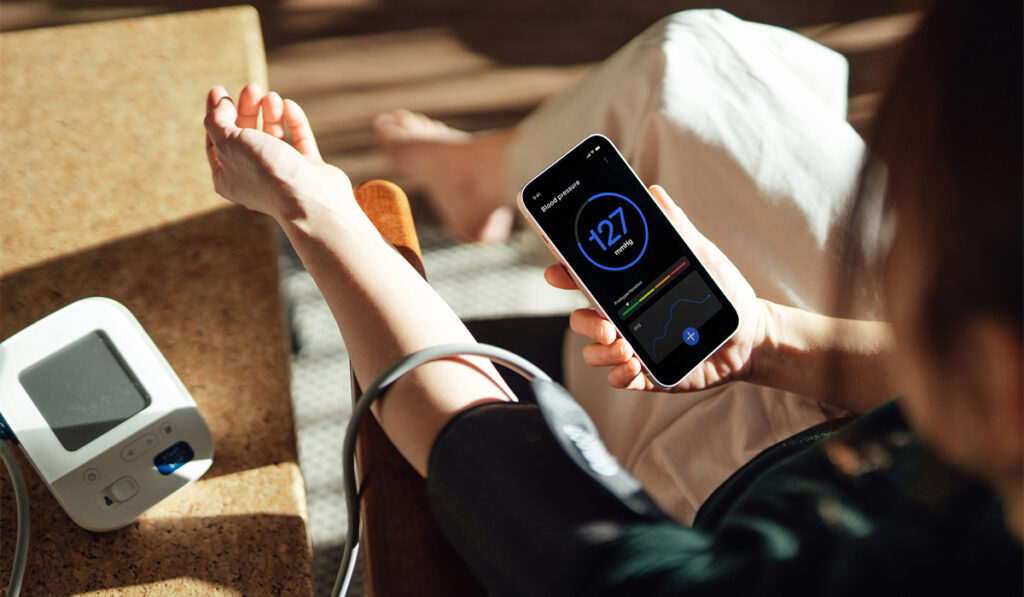Hospital-at-home programs have been growing nationwide since the pandemic, spurring development of essential health-information technology to help care for these off-site patients.
Brett Young, M.S.N., R.N., manager of Vanderbilt’s Hospital at Home Unit, spearheaded a range of modifications to speed up identification of patients as suitable for treatment outside of the hospital and to confirm that their in-home experience meets or exceeds the quality of traditional in-patient care.
“The patients who participate love it. Their satisfaction is through the roof.”
Young said the most critical modification allowed his staff to quickly locate, monitor, evaluate and contact patients already in the hospital who were considered to be likely candidates for treatment at home.
“The patients who participate love it. Their satisfaction is through the roof,” said Victor Legner, M.D., an associate professor of medicine at Vanderbilt University Medical Center.
Ryan Starnes, M.S.H.A., senior director of operations for the program, said innovation has been a hallmark of Hospital at Home since its inception, thus the use of advanced methods for identifying patient candidates is a natural next step.
“With the wealth of data that we have in the electronic medical record, it just makes sense to use that information to make our work simpler, while also allowing us to extend this service to more patients,” Starnes said.
Who Qualifies
On an average day, Vanderbilt’s main hospital serves from 800 to 850 inpatients. Young’s team will consider about 200 patients for eligibility to transition to hospital-at-home care based on their zip code and insurance payor.
“The biggest modification to the health record was a system to figure out who we are fishing for in this big old pond; finding the right patients is toug.h.”
“The biggest modification to the health record was a system to figure out who we are fishing for in this big old pond; finding the right patients is tough,” Young said. The system we came up with applies some rules to get us from 800 to 200 immediately.”
The program has the capacity to handle eight people on any given day. Some days there are between zero and two patients enrolled. Other days, six or seven may be added, for an average daily count of four to five patients.
“We’ve been successful in increasing our volume, particularly during this fiscal year,” Young said. The average daily census has roughly doubled, going from an average of two-and-a-half patients per day in early 2023 to, as stated above, an average of four-and-a-half patients .in October 2023.
“Finding the right patients is tough,” Young emphasizes, adding that several criteria must be satisfied in each case.
Patient Status Categories
After reviewing the relevant factors, including the distance from their home to the hospital and medical coverage for this type of care, the team assigns each to patient to one of several status lists.
“The highest priority list includes patients that we feel most confident about on any given day; it’s called the ‘pursuing’ List. “We usually have anywhere six to 10 patients on that list.”
Certain types of cases are the first to be considered. Patients with urologic problems and infections are among those most likely to be suitable, for example.
A second category of patients appear on a “following” list and are considered potentially ready to join the program within the next 24 hours. A third list contains patients who may be eligible at a point beyond 24 hours.
Finally, a fourth list is compiled that includes patients suitable for periodic review. For these patients, Young said, “a lot of things will need to change for them to be ready. Maybe they’re in ICU but if some things change, they may look like better candidates.”
Disqualifying Conditions
Deemed ineligible are patients whose cases involve certain conditions that can’t be optimally treated through hospital-at-home . These include those who require kidney dialysis or who are hospitalized for a substance-use disorder or those having a sickle cell crisis.
“We cannot dialyze patients at home. We see a possibility of doing round trips for dialysis at some future date, but not yet,” Young said.
Another Hospital Floor
Modifications to the electronic health record allow patient homes to be listed as a section of the hospital. Staff and clinicians strive to replicate the experience of a traditional hospital stay for those in the program.
“We are extending a truly inpatient encounter to your house, like it’s another med-surg floor. It’s such a new way of thinking.”
“We are extending a truly inpatient encounter to your house, like it’s another med-surg floor. It’s such a new way of thinking,” he said.
Payers Can Differ
Medicare covers hospital-at-home services, but as of early 2024, few private insurers do.
Young stated that United Healthcare has adopted the program for coverage, but Blue Cross Blue Shield has not. Aetna participates in a limited way.
“The limiting factor nationally for hospital-at-home to truly blossom is adoption by commercial insurers,” Young said.
In 2023, Vanderbilt entered a pilot study of at-home care for patients working with Blue Cross Blue Shield. Young hopes the large insurer will add coverage for hospital-at-home patients in the near future. Some northeastern states require all insurers to cover the programs through state legislation. Young has observed that inpatient care at home bring many emotional benefits to patients.
“Seeing patients at home, they look so different– wearing regular clothes and sleeping good,” Young said. “Take a 75-year-old man who lost his wife, but it’s him and his dog. He wants to be home in the recliner with the dog, having normal routines.”





